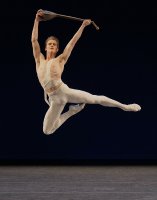By Rachel Straus
New York City Ballet’s new staging of “The Seven Deadly Sins,” which had its premiere at the company’s spring gala on May 11, puts Kurt Weill and Bertolt Brecht’s dark, sinister “ballet chanté” of 1933 into a new context: a tinsel-town soundstage, complete with unison hoofers in the grand finale. Choreographer Lynn Taylor-Corbett, whose credits include Broadway’s “Swing,” has essentially created a Cliff Notes version of this irony-laced yarn, dragging principal dancer Wendy Whelan and guest artist Patti Lapone through seven shallow scenes of human transgression and stripping the work of its brooding soul.
In the original 1933 production, choreographed by George Balanchine for Les Ballets 1933, singer Lotte Lenya and dancer Tilly Losch were presented as Anna I and II, yin yang composites of the same woman. The fact that Lenya and Losch bore a striking resemblance to each other, and were about the same age, probably helped Kurt Weill and Bertold Brecht’s scenario. It concerns the Annas experiencing seven American cities, encountering seven “deadly” sins, and struggling with each other’s opposite personalities.
When Balanchine revived the work in 1958, he cast the 21-year-old Allegra Kent across from the significantly older Lenya. New York Times dance critic John Martin dubbed the production “a stunning revival of a minor masterpiece.” But not all critics concurred, though the vision of Kent carried aloft on a human-size plate wearing just lingerie lingered in the mind, says dance writer Deborah Jowitt.
Balanchine was never afraid of being naughty. He also wasn’t afraid of “Seven Deadly” dissapearing after its run. No one filmed the performance. This may say more about what Balanchine thought of his “minor masterpiece” than City Ballet’s capacity to film performances in the 1950s. But this point is conjecture.
Now flash forward 60 years. At a City Ballet studio event, Lynn Taylor-Corbett suggests to Peter Martins that she make a reintepreted revival of “Seven Deadly Sins.” With a penchant for commercially-driven projects, Martins agrees to the venture and to Taylor-Corbett’s casting of the matronly-looking Patty Lapone, who sings like a battle ax, and the bone-thin Wendy Whelan, who dances like a steely wraith. The hope was that the project would bring in new audiences (read Broadway ticket holders). At the gala, I did see Matthew Broderick arm and arm with his wife Sarah Jessica Parker.
Unfortunately, on stage Whelan and Lapone never formed a convincing relationship, twin-like, sisterly, or otherwise. Lapone mostly stood on the sidelines, serving as singing narrator. Whelan danced Taylor-Corbett’s forgettable choreography, becoming a pawn rather than a protagonist in the rapidly unfolding events.
The greatest interest in Taylor-Corbett’s ballet was Beowulf Boritt’s sets of seven cities. In Memphis, where the sin is “Pride,” Whelan flitted about in imitation of Isadora Duncan during an audition for a sleeze-style cabaret. The black and red décor said bordello, as did the lighting by Jason Kantrowitz. In San Francisco, where the sin was “Envy,” Boritt’s backdrop of quaint Victorian row houses against a boundless blue sky was enviable. In Baltimore, where the sin was “Greed,” Boritt created a salon, channelling both Phillipe Starck’s overblown modernism and the Belle Epoque’s love of patterns. From two gargantuan black and white striped, tasseled love seats, Anna’s overfed suitors embarked on a mutually fatal duel.
As for Taylor-Corbett’s choreography, it lacked movement invention or good movement imitation. In Boston, where the sin was “Lust,” Whelan and Craig Hall peformed a romantic pas de deux. Muscular and in a wife beater, Hall looked like Marlon Brando in Elia Kazan’s film version of “Street Car Named Desire.” He lifted Whelan aloft in shapes and transitions that looked exactly like moments in Christopher Wheeldon’s “After the Rain”—which Whelan and Hall perform frequently.
Following the performance, this reviewer read the Brecht text, which was translated into English by W.H. Auden and Chester Kallman. What crystalized from the text, but not from Taylor-Corbett’s production, is that the production hinges on demonstrating the conflict between the Annas: Anna I wants money and power; Anna II wants love and a creative outlet. Also, Anna II allows Anna I to push her around. But only in the last scene of Taylor-Corbett’s work is their conflict delivered without a doubt and Anna II emerges triumphant. As Anna II (Whelan) collapses in front of her families’ spiffy new home, Anna I (Lapone) walks up the stairs in a mink, looking like a character from “The Real Housewives of Beverly Hills.”
The gala’s second half was devoted to Balanchine’s “Vienna Waltzes,” which premiered at the 1977 City Ballet gala. If you don’t care for the music of Johann Strauss II, Franz Lehar, or Richard Strauss or for watching a carousel vision of dancers waltzing for 46 minutes, this ballet may not be for you. But despite the work’s repetitiousness, “Waltzes” is visual spendor at its finest; Karinska’s five sets of costumes, ranging from full-skirted 1860s crinoline ball gowns to sleek white silk Roaring Twenties dresses are a fashionista’s delight.
In the pit, Clotilde Otranto energetically conducted such ditties as the “Explosions-Polka” and excerpts from “Der Rosenkavalier.” Principals Maria Korowski, Jennifer Ringer and Megan Fairchild demonstrated their strikingly differing styles through the same steps. That said all City Ballet dancers waltz with a brilliant elegance.
